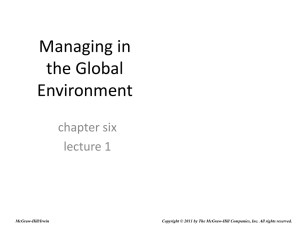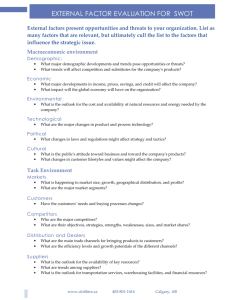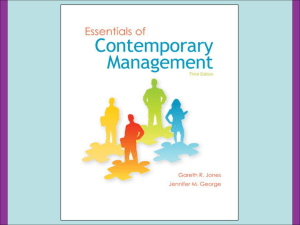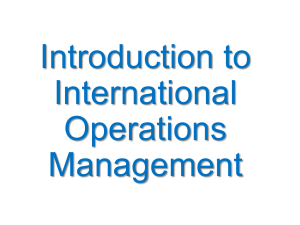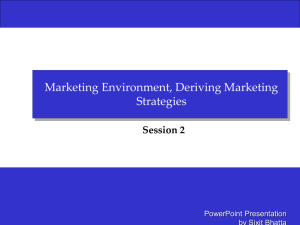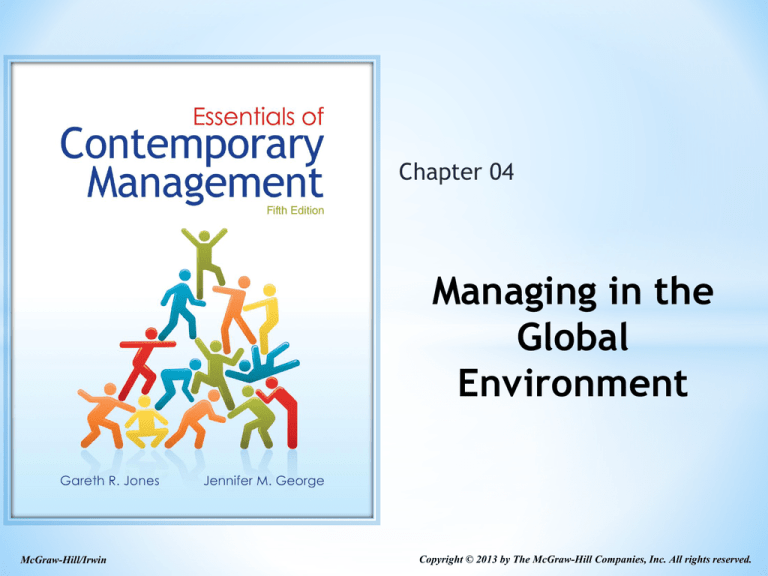
Chapter 04
Managing in the
Global
Environment
McGraw-Hill/Irwin
Copyright © 2013 by The McGraw-Hill Companies, Inc. All rights reserved.
Learning Objectives
• Explain why the ability to perceive, interpret, and
respond appropriately to the global environment is
crucial for managerial success
• Differentiate between the global task and global
general environments
• Identify the main forces in both the global task and
general environments and describe the challenges
that each force presents to managers
4-2
Learning Objectives
• Explain why the global environment is becoming
more open and competitive and identify the forces
behind the process of globalization that increase
the opportunities, complexities, challenges, and
threats that managers face
• Discuss why national cultures differ and why it is
important that managers be sensitive to the effects
of falling trade barriers and regional trade
associations on the political and social systems of
nations around the world
4-3
*
Global Business
The buying and selling of goods and
services by people from different
countries.
1
4
*
Multinational Corporation
A corporation that owns businesses in
two or more countries.
Direct Foreign Investment
A method of investment in which a
company builds a new business or buys an
existing business in a foreign country.
1.1
5
*
* United Kingdom-$432,488,000,000
* Japan-$257,273,000,000
* Netherlands-$217,050,000,000
* Germany-$212,915,000,000
* Canada-$206,139,000,000
* Switzerland-$192,231,000,000
* France-$184,762,000,000
* Luxembourg-$181,203,000,000
* Total-$2,342,829,000,000
6
*
Investment
coming into
the U.S., like
this Honda
Motor plant in
Ohio, totaled
$106 billion in
2004.
1.1
7
*
* Netherlands-$521,427,000,000
* United Kingdom-$508,369,000,000
* Luxembourg-$274,923,000,000
* Bermuda-$264,442,000,000
* Ireland-$190,478,000,000
* Switzerland-$143,627,000,000
* Australia-$133,990,000,000
* Japan-$113,263,000,000
* Germany-$105,828,000,000
8
What is the Global Environment?
• Global organizations
•
Operating in the global environment is uncertain
and unpredictable
• Global environment
•
Set of global forces and conditions that operate
beyond an organization’s boundaries but affect a
manager’s ability to acquire and utilize resources
4-9
What is the Global Environment?
• To identify opportunities or threats caused by forces in
the environment, it helpful for managers to distinguish
between the task environment and the more
encompassing general environment.
• The task environment is the set of forces and conditions
that affect an organization’s ability to obtain inputs and
dispose of its outputs. It consists of the organization’s
suppliers, customers, distributors, and competitors, and
has the most immediate and direct effect on managers.
• The general environment includes the wide-ranging
global, economic, technological, socio-cultural,
demographic, political and legal forces that affect the
organization and its task environment.
4-10
Figure 4.1 - Forces in the Global
Environment
4-11
The Task Environment
• The set of forces and conditions that originate with
global suppliers, distributors, customers, and
competitors:
•
Affect a manager’s ability to obtain resources and
dispose of outputs
•
Have a significant impact on short-term decision
making
4-13
Question
What are individuals and organizations that provide
an organization with the input resources that it
needs to produce goods and services?
A. Customers
B. Suppliers
C. Distributors
D. Competitors
4-14
The Task Environment
• Suppliers: Individuals and organizations that
provide an organization with the input resources
that it needs to produce goods and services
•
Raw materials, component parts, labor (employees)
• Relationships with suppliers can be difficult due to
materials shortages, unions, and lack of substitutes
•
Suppliers that are the sole source of a vital item
will be in a strong bargaining position to raise their
prices
• Managers can reduce these supplier effects by
increasing the number of suppliers of an input
4-15
The Task Environment
• Suppliers
• Changes in the nature, numbers or types of any supplier
may result in opportunities and threats to which
managers must respond. Depending upon these factors, a
supplier’s bargaining position may be either strong or
weak.
• At a global level, managers have the opportunity to buy
products from foreign suppliers or to become their own
suppliers and manufacture their own products abroad. It
is important that managers recognize the opportunities
and threats associated with managing to global supply
chain
• Most large global companies utilize global outsourcing.
4-16
The Task Environment
• Global outsourcing: Purchase or production of
inputs or final products from overseas suppliers to
lower costs and improve product quality or design
•
Has grown enormously to take advantage of
national differences in the cost and quality of
resources
4-17
The Task Environment
• Distributors: Organizations that help other
organizations sell their goods or services to customers
• Changing nature of distributors and distribution
methods can bring opportunities and threats for
managers-Fedex, UPS
• The power of a distributor may be strengthened
or weakened depending upon its size and the
number of distribution options available.
•
Large and powerful distributors can control access
to a particular organization’s goods and services
• It is illegal for distributors to collaborate or
collude to keep prices high and thus maintain
their power over buyers.
4-18
The Task Environment
• Customers: Individuals and groups that buy the
goods and services that an organization produces
•
•
•
An organization’s success depends on its
responsiveness towards satisfying customers' needs
Changes in the number and types of customers or in
customers’ tastes and needs can result in
opportunities or threats for managers.
The most obvious opportunity associated with
expanding into the global environment is the
prospect of selling goods and services to new
customers.
4-19
The Task Environment
• Competitors: Organizations that produce goods and
services that are similar to a particular
organization’s goods and services
•
Strong competitive rivalry results in price
competition, and falling prices reduce customer
revenues and profits
•
Potential competitors are the organizations that
are not at present in a task environment but could
enter if they so choose.
4-20
Figure 4.2 - Barriers to Entry and
Competition
Factors that make it difficult and costly for a company to
enter a particular task environment.
4-21
Question
What are pressures emanating from the social
structure of a country or society or from the
national culture?
A. Economic forces
B. Technological forces
C. Socio-cultural forces
D. Demographic forces
4-22
Barriers to Entry and Competition
• Economies of scale are the cost advantages associated
with large operations. They may result from
manufacturing products in large quantities, buying inputs
in bulk, or by fully utilizing the skills and knowledge of
employees.
• Brand loyalty is a customers’ preference for the products
of organizations currently in the task environment. If
established organizations enjoy significant brand loyalty,
a new entrant will find it difficult and costly to obtain a
market share.
• At the national and global level, administrative barriers
are government policies that create barriers to entry and
limit the imports of goods by overseas companies.
4-23
The General Environment
• An organization’s general environment can have
profound effects upon its task environment which
may not be evident to managers.
• Therefore, managers must constantly analyze
forces in the general environment because these
forces affect ongoing planning and decisionmaking.
• Economic, technological, sociocultural,
demographic, political, and legal forces in the
general environment have important effects on
forces in the task environment
4-24
The General Environment
• Economic forces: Interest rates, inflation, unemployment,
economic growth, and other factors that affect the general health
and well-being of a nation or the regional economy of an
organization
• Economic forces produce many opportunities and threats for
managers.
• Strong macroeconomic conditions, such as low levels of
unemployment and falling interest rates, often create
opportunities for organizations to flourish.
• Worsening macroeconomic conditions, such as recession or rising
inflation rates, often pose a threat to organizations because they
limit management’s ability to gain access to the resources they
need.
• Worsening macroeconomic conditions, such as recession or rising
inflation rates, often pose a threat to organizations because they
limit management’s ability to gain access to the resources they
need.
4-25
The General Environment
• Technology is the combination of skills and equipment
that managers use in the design, production, and
distribution of goods and services.
• Technological forces are the outcomes of changes in
the technology that managers use to design, produce,
or distribute goods and services and can have profound
implications for managers and organizations.
• Technological change can create a threat to
organizations by making established products obsolete. It
can also create a host of opportunities for the
development of new products or processes.
• Managers must move quickly to respond to such changes
if their organizations are to survive and prosper.
4-26
Question
What technology has had the biggest impact on
business in the last 50 years?
A. Internet
B. Cell phones
C. Computers
D. Email
4-27
The General Environment
• Sociocultural forces: Pressures emanating from the social
structure of a country or society or from the national
culture
•
•
•
•
Social structure: Traditional system of relationships
established between people and groups in a society
National culture: Set of values that a society considers
important and the norms of behavior that are approved or
sanctioned in that society
Social structure and national culture not only differ across
societies but also change within societies over time.
Individual managers and organizations must be responsive
to changes in, and differences among, the social
structures and national cultures of all the countries in
which they operate.
4-28
The General Environment
• Demographic forces: Outcomes of change in, or changing
attitudes toward, the characteristics of a population, such as
age, gender, ethnic origin, race, sexual orientation, and social
class
• Demographic forces present managers with opportunities
and threats and can have major implications for
organizations.
• Most industrialized nations are experiencing the aging of
their populations as a consequence of falling birth and
death rates and the aging of the baby boom generation.
• The aging of the population also has several implications
for the workplace:
• decline in the number of young people joining the workforce
• older employees postponing retirement
4-29
The General Environment
• Political and legal forces: Outcomes of changes in
laws and regulations, such as the deregulation of
industries, the privatization of organizations, and
increased emphasis on environmental protection
• A nation’s political processes shape laws that
constrain the operations of organizations and
managers, thereby creating both opportunities
and threats.
• Political integration of countries is an important
political and legal force affecting managers and
organizations
4-30
The Global Environment
4-31
The Changing Global Environment
• 21st century has banished the idea that the world
is composed of distinct national countries and
markets that are separated physically,
economically, and culturally
• As a result of falling trade barriers, managers view
the global environment as open—free to buy and
sell goods and services across the globe
4-32
The Process of Globalization
• Globalization
•
Globalization is the set of specific and general
forces that work together to integrate and connect
economic, political, and social systems across
countries, cultures, or geographical regions.
•
The result of globalization is that nations and people
become increasingly interdependent because the
world’s markets and businesses become increasingly
interconnected.
• Economic advances associated with
globalization result from capital flows Human, Financial, Resource, Political
4-33
The Process of Globalization
• Human capital: the flow of people around the world
through immigration, migration, and emigration
• financial capital: the flow of money across world
markets through overseas investment, credit, lending,
and aid.
• Resource capital: the flow of natural and semi-finished
products between companies and countries such as
metal, minerals, lumber, energy, food products,
microprocessors, and auto parts
• Political capital: the flow of power and influence
around the world using diplomacy, persuasion,
aggression, and armed forces to protect right or access
of a nation, world region, or political bloc to the other
forms of capital.
4-34
*
Tariff
Quotas
Voluntary export restraints
Nontariff
Barriers
Government import standards
Government Subsidies
Customs Valuation / Classification
1.2
35
Declining Barriers to Trade and
Investment
• Free-trade doctrine: Idea that, if each country
specializes in the production of the goods and
services that it can produce most efficiently, this
will make the best use of global resources
• Removing barriers to the free flow of resources and
capital between countries, through an international
treaty known as the General Agreement on Tariffs
and Trade lead to the rise of free trade
4-36
Declining Barriers of Distance
and Culture
• Advances in communications and transportation
technology has reduced the barriers of distance
and culture
• Revolutionary developments in satellites, digital
technology, the Internet and global computer
networks, and video teleconferencing make
communication reliable, secure, and instantaneous
4-37
Effects of Free Trade on Managers
• Declining trade barriers
•
Has created enormous opportunities for companies
to expand the market for their goods and services
through exports and investments in countries
overseas
•
The growth of regional trade agreements such as
the North American Free Trade Agreement (NAFTA),
the Central American Free Trade Agreement
(CAFTA), presents opportunities and threats for
managers and their organizations
4-38
The Role of National Culture
• Values: Ideas about what a society believes to be
good, desirable and beautiful
•
Provides conceptual support for notions of
individual freedom, democracy, truth, justice,
honesty, loyalty, social obligation, collective
responsibility, appropriate roles for men, and
women
•
Not static and change over time
4-39
The Role of National Culture
• Norms: Unwritten, informal codes of conduct that
prescribe appropriate behavior in particular
situations and are considered important by most
members of a group or organization
• Mores: Norms that are considered to be central to
functioning of society and to social life
• Folkways: Routine social conventions of everyday
life
4-40
Hofstede’s Model of National Culture
• Individualism: Worldview that values individual
freedom and self-expression and adherence to the
principle that people should be judged by their
individual achievements rather than by their social
background
• Collectivism: Worldview that values subordination
of the individual to the goals of the group and
adherence to the principle that people should be
judged by their contribution to the group
4-41
Hofstede’s Model of National Culture
• Power distance: Degree to which societies accept
the idea that inequalities in the power and wellbeing of their citizens are due to differences in
individuals’ physical and intellectual capabilities
and heritage
• Achievement orientations: Worldview that values
assertiveness, performance, success, and
competition
• Nurturing orientation: Worldview that values
quality of life, warm personal friendships, and
services and care for the weak
4-42
Hofstede’s Model of National Culture
• Uncertainty avoidance: Degree to which societies
are willing to tolerate uncertainty and risk
• Long-term orientation: Worldview that values
thrift and persistence in achieving goals
• Short-term orientation: Worldview that values
personal stability or happiness and living for the
present
4-43
Figure 4.4 - Hofstede’s Model of
National Culture
4-44
National Culture and Global Management
• Management practices that are effective in one
culture might be troublesome in another
• Managers must be sensitive to the value systems
and norms of an individual’s country and behave
accordingly
• Culturally diverse management team can be a
source of strength for an organization
4-45

